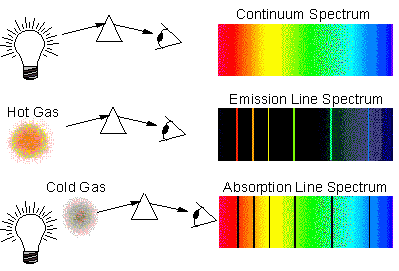Stellar Spectra (original) (raw)
We may consider three principal types of spectra which appear when the light from an object is broken up into its component wavelengths or "dispersed":
- a continuous spectrum or continuum; the emission of a thermal spectrum is one type of continuum.
- an absorption spectrum or sometimes an absorption-line spectrum.
- an emission spectrum or emission-line spectrum.

An absorption spectrum is produced when a continuum passes through "cooler" gas. Photons of the appropriate energies are absorbed by the atoms in the gas. Although the photons may be re-emitted, they are effectively removed from the beam of light, resulting in a dark or absorption feature. The atmospheres of stars act as a cooler blanket around the hotter interior of a star so that typical stellar spectra are absorption spectra.

Spectral Classification
The systematic classification of stars in terms of absorption features and the understanding that suchspectral classification is essentially a sequence in atmospheric temperature was due to Annie J. Cannon at Harvard.
| Stellar Spectral Classification | |||||||
|---|---|---|---|---|---|---|---|
| SpectralType | Atmospheric Temperature (K) | Hydrogen (Balmer) Features | Other Features | M/M |
R/R |
L/L |
Main Sequence Lifetime |
| O | >33,000 K | weak | Ionized Helium (He+) features sometimes in emission Strong UV continuum | 20-60 | 9-15 | 90,000-800,000 | 10-1 Myr |
| B | 10,500-30,000 K | medium | Neutral He absorption | 3-18 | 3.0-8.4 | 95-52,000 | 400-11 Myr |
| A | 7,500-10,000 K | strong | H features maximum at A0 Some features of heavy elements, eg Ca+ | 2.0-3.0 | 1.7-2.7 | 8-55 | 3 Gyr - 440 Myr |
| F | 6,000-7,200 K | medium | 1.1-1.6 | 1.2-1.6 | 2.0-6.5 | 7-3 Gy | |
| G | 5,500-6,000 K | weak | Ca+ H&K, Na "D" Sun is G2V | 0.9-1.05 | 0.85-1.1 | 0.66-1.5 | 15-8 Gy |
| K | 4,000-5,250 K | v. weak | Ca+, Fe, Strong molecules, eg CH, CN | 0.6-0.8 | 0.65-0.80 | 0.10-0.42 | 17 Gy |
| M | 2,600-3,850 K | v. weak | Molecules, eg TiO Very red continuum | 0.08-0.5 | 0.17-0.63 | 0.001-0.08 | 56 Gy |
| L | < 0.08 |
Class "W" stars are very hot stars known as "Wolf-Rayet" Stars.
"R", "N", "S" stars are cool stars with particular types of molecular bands.
"L" stars are possibly not truly stars at all, in the sense that they may not have nuclear reactions at their cores.
Click on the spectral type above to see spectra of the appropriate type or click here to see Spectral Types O - Gand here for Spectral Types G - M
Click here for a selection of Spectral Sequencemnemonics
The Stellar Spectral Sequence as a Temperature Sequence
The temperature of the stellar photosphere determines the rate and severity of collisions between molecules, atoms and ions which in turn determines:
- the molecular equilibrium - if the star is too hot, fragile molecular bonds will be broken apart. Most molecules such as TiO are seen only in spectra of the coolest stars ( T = 3000 -- 4000K). Strong molecules such as CH and CN can be seen in somewhat hotter stars like the sun.
- the ionization equilibrium - the hotter the temperature, the higher the ionization state of the atoms in the stellar atmosphere will be. Atoms are ionized (or partially ionized) when they lose or gain an electron. In cool stars most atoms will be neutral. At higher Temperature, easily ionized atoms such as Na, Ca, etc, will be ionized; above T = 10,000K hydrogen becomes ionized and above about 15,000K helium becomes ionized.
- the number of atoms in excited states. At low T, almost no H atoms are in the n=2 orbit, capable of absorbing "Balmer" photons, but as T increases the n=2 population increases and we see the hydrogen features, reaching a maximum in stars with T = 10,000.
Among the other things that we may determine from the absorption spectrum are: density, chemical composition, magnetic field strength, and radial velocity. These are all secondary effects compared to temperature.
- Jim Kaler's Stars Website dedicated to showing that not all stars are the same.

 The Sun
The Sun  Thermal Radiation
Thermal Radiation  Education & Outreach
Education & Outreach  CASS Home
CASS Home
Conducted by Gene Smith, CASS/UCSD.
Comments? You may send email to hsmith@ucsd.edu
Prof. H. E. (Gene) Smith
CASS 0424 UCSD
9500 Gilman Drive
La Jolla, CA 92093-0424
---
Last updated: 16 April 1999